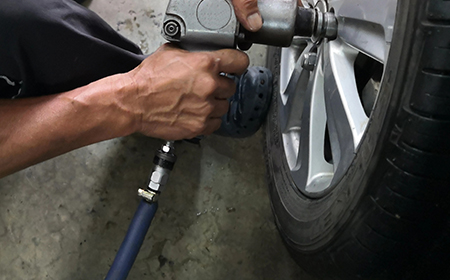The first step is to evaluate your surroundings and situation for safety. Is it a safe area to change the tire yourself, or should you call for help? If you elect to change the tire yourself, make sure to pull over to a safe space out of the way of oncoming traffic, and that the roadway is level. The following are general instructions for changing tires. Your owner’s manual will have more detailed instructions about the operation of the specific equipment:
1. Make sure your car is in “park”. If you have manual transmission, make sure it is in gear.
2. Block your other tires with a rock, etc., to keep the car from rolling.
3. Use your tire iron to loosen the wheel lugs, but don’t remove them yet. When the lugs are stuck, and you need to break them free. To do so, you can elongate the tire iron with a length of metal pipe around its handle to significantly increase its torque. Remember to turn the lugs counter-clockwise to loosen them.
4. Be careful of hot asphalt, as your jack can push down into it when carrying the weight of your car. You can spread out and diffuse that weight by placing a strong wooden board under the jack.
5. Attach the jack to the specific pre-selected spots on the frame of your vehicle. You can find those spots in your Owner’s Manuel. Sometimes, the diagram is also pasted in the interior of your trunk or even on the jack itself.
6. Jack up the car. Make sure it is high enough to put on the spare, which will be taller than the flat tire because it is full of air.
7. Remove the tire lugs completely and remove the wheel. You may have to gently kick the tire on the left and right sides of the sidewall to loosen the wheel if it is stuck. Be very careful not to not knock the car off the jack.
8. Clean the hub of any loose debris to allow the new wheel to seat correctly.
9. Hold the wheel up and line up the holes with the wheel studs. Your spare can be rather heavy, so be careful. Push the wheel onto the studs, and screw on the lugs lightly with your fingers.
10. Use the tire iron to tighten them more, but not to the ultimate tightness. You want to do this in stages working in a star pattern tightening the lug opposite.
11. Check to assure that the wheel is seated correctly against the wheel hub.
12. Lower the car to the ground for the final tightening. The weight of the car on the tires will keep them from turning when you apply more pressure to tighten them as much as you can.
After changing the tire, you should drive directly to a tire dealership or garage for repair of the flat tire or replacement. Remember that if your spare tire was a ‘temporary’ spare, it probably has a maximum speed of 50 mph. Check the maximum speed details, and any other restrictions listed on the side of the tire or owner’s manual.
